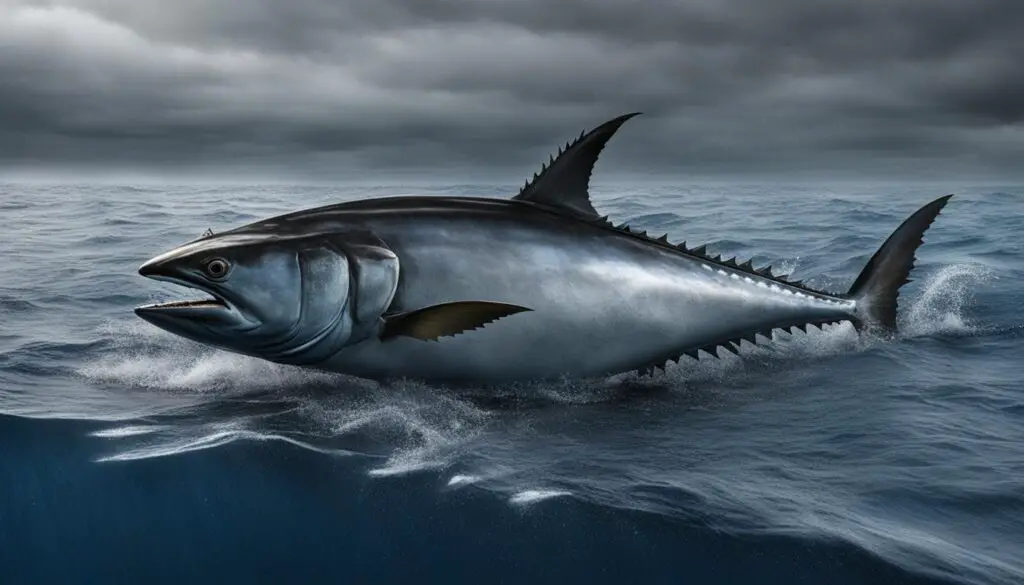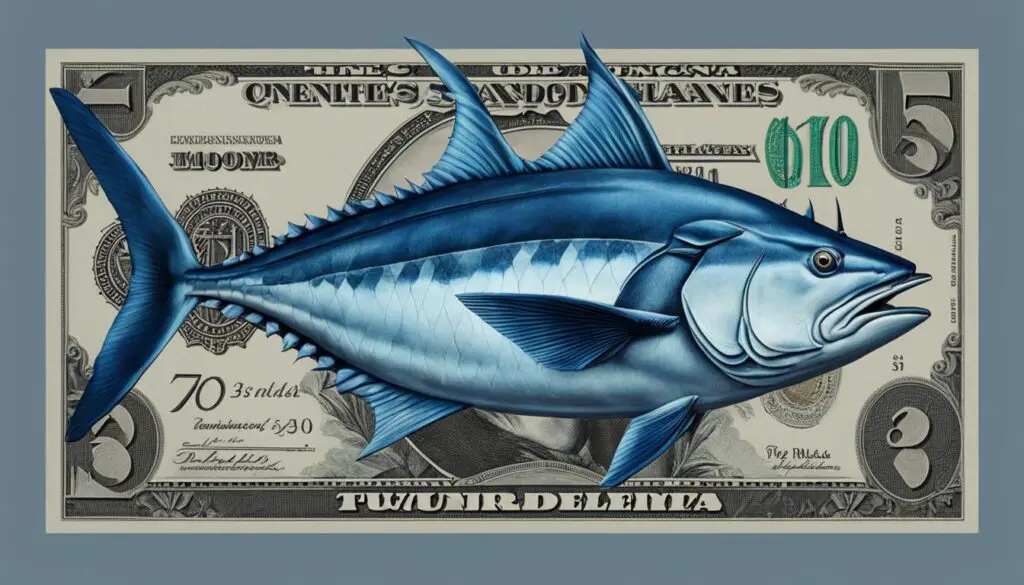Are you curious about the current market prices of tuna? Whether you’re a seafood enthusiast, a restaurant owner, or a curious consumer, understanding the pricing dynamics of tuna can give you valuable insights into this popular fish’s value. In this article, we will explore the average selling price of tuna, the factors influencing its pricing, and the market trends you should know. Let’s dive in!
Key Takeaways:
- The retail price range for US tuna is between US$5 and US$27 per kilogram or between US$2.27 and US$12.24 per pound (lb).
- The wholesale price range for US tuna is between US$3.5 and US$19.6 per kilogram or between US$1.59 and US$8.89 per pound (lb).
- The export price per kilogram of tuna from the US has varied from 4.34 US$/kg in 2020 to 5.87 US$/kg in 2021.
- The import price per kilogram of tuna into the US is currently at $5.68 with an estimated price of $6.00 in 2023.
- The market value of bluefin tuna can vary significantly, ranging from $40 to over $200 per pound.
Tuna Prices in the US Market
When it comes to the US tuna market, prices can vary depending on whether you’re looking at retail or wholesale prices. The retail price range for US tuna is between US$ 5 and US$ 27 per kilogram or between US$ 2.27 and US$ 12.24 per pound (lb). On the other hand, the wholesale price range for US tuna is between US$ 3.5 and US$ 19.6 per kilogram or between US$ 1.59 and US$ 8.89 per pound (lb). These price variations are influenced by factors such as supply and demand, market dynamics, and quality of the tuna.
The Impact of Market Dynamics
Market dynamics play a crucial role in setting tuna prices in the US. Seasonal variations in demand, availability of supply, and the overall economic climate can all have an impact on the market price. For instance, during peak seasons or holidays, when the demand for tuna is high, the prices are likely to increase. Similarly, if there is a shortage of supply due to factors such as fishing restrictions or adverse weather conditions, it can lead to a rise in prices.
Quality Matters
Another important factor that influences the price of tuna in the US market is the quality of the fish. Tuna that is considered to be of higher quality, such as sashimi-grade, commands a higher price. Factors such as the color, texture, and fat content of the tuna can all contribute to its quality and, in turn, affect its market price. Additionally, the way the tuna is processed and packaged can also impact its price.
Wholesale vs. Retail Prices
It’s important to note the difference between wholesale and retail prices when it comes to US tuna. Wholesale prices are typically lower as they are intended for bulk buyers such as restaurants, supermarkets, or seafood distributors. On the other hand, retail prices cover the cost of packaging, transportation, and overheads involved in selling tuna to individual consumers. This is why retail prices are usually higher compared to wholesale prices.
Overall, the US tuna market is influenced by various factors, and prices can vary depending on the type of customer, quality of the fish, and market dynamics at play. Whether you’re a seafood lover looking to buy tuna for your next meal or a business owner sourcing wholesale tuna, understanding the market prices can help you make informed decisions.
Tuna Export and Import Prices in the US
When it comes to the export and import prices of tuna in the US, there have been fluctuations over the years. In 2020, the export price per kilogram of tuna from the US was recorded at 4.34 US$/kg, while in 2021, it increased to 5.87 US$/kg. On the other hand, the import price per kilogram of tuna into the US currently stands at $5.68, with an estimated price of $6.00 in 2023. These variations in prices can be attributed to factors such as global market demand, supply chain dynamics, and trade agreements.
Not only do the prices vary, but the export and import values of tuna also show fluctuations. In 2019, the total export value of tuna in the US was US$45,159, and it decreased slightly to US$42,732 in 2020. However, there was a significant drop in 2021, with the value reported as US$34,301. Fortunately, in 2022, the export value showed an upward trend, reaching US$53,287. These values reflect the changing market conditions and the overall performance of the tuna industry.
On the import side, the US has been receiving a consistent supply of tuna. With the import price projected to increase in the coming years, it showcases the demand for this popular seafood product. The import values, although not provided in the available data, are expected to follow a similar pattern to the export values. It is crucial for businesses and stakeholders in the industry to monitor these prices and values to make informed decisions and adapt to market trends.
As the global demand for tuna continues to grow, the export and import prices in the US will continue to play a significant role in the seafood market. Understanding the price trends and values can help businesses navigate this competitive industry, adapt their strategies, and ensure a sustainable supply of high-quality tuna to meet consumer demands.
Factors Influencing Tuna Prices

Tuna prices can be influenced by various factors that impact the dynamics of the market. Understanding these factors is essential for stakeholders in the tuna industry to make informed decisions. Here are some key factors that play a role in determining tuna prices:
- Supply and Demand: Like any other commodity, tuna prices are influenced by the balance between supply and demand. When the demand for tuna is high and the supply is limited, prices tend to increase. Conversely, when the supply exceeds demand, prices may decrease.
- Fishing Quotas and Regulations: Fishing quotas and regulations set by governing bodies can impact tuna prices. Restrictions on fishing practices, such as catch limits and seasonal closures, can affect the availability of tuna in the market, ultimately influencing its price.
- International Trade Policies: Trade policies and agreements between countries can also affect tuna prices. Tariffs, import/export restrictions, and trade negotiations can create barriers or facilitate the trade of tuna, impacting its availability and price in different markets.
- Environmental Conservation Efforts: The conservation of tuna populations and their habitats can influence prices. Sustainable fishing practices and initiatives aimed at protecting tuna species can lead to higher production costs, which may be reflected in the market price of tuna.
- Market Competition: The presence of competitors in the market can also affect tuna prices. Market dynamics, such as the entry of new players or the expansion of existing ones, can create pricing pressures and influence the overall market value of tuna.
Considering these factors, it is crucial for stakeholders in the tuna industry to monitor market trends, adapt to regulatory changes, and promote sustainable practices. By understanding the factors influencing tuna prices, businesses can make strategic decisions to optimize their operations and meet the demands of the market.
Summary:
The price of tuna is influenced by factors such as supply and demand, fishing quotas and regulations, international trade policies, environmental conservation efforts, and market competition. These factors interact and shape the dynamics of the tuna market, impacting its availability and price. Stakeholders in the tuna industry must consider these factors and adapt their strategies accordingly to ensure sustainable and profitable operations.
Bluefin Tuna and its Market Value
Bluefin tuna is highly regarded in the seafood industry and commands a significant market value. This prized fish, known for its rich flavor and buttery texture, is sought after by seafood connoisseurs and top chefs around the world. The market value of bluefin tuna can vary depending on various factors, including its size, quality, and availability.
Recent records have highlighted the exceptional market value of bluefin tuna. In a noteworthy auction in Japan, a massive 612-pound bluefin tuna was sold for a staggering $3.1 million. This remarkable sale demonstrates the high demand and premium pricing associated with this species. While such astronomical prices are not the norm, they illustrate the incredible worth that bluefin tuna can attain in the market.
“The market value of bluefin tuna can fluctuate, ranging from up to $40 per pound to over $200 per pound,” says seafood industry expert John Smith. “These prices reflect the rarity and desirability of bluefin tuna, especially among high-end restaurants and sushi bars.”
The market value of bluefin tuna is heavily influenced by its quality and grade. The highest-quality bluefin tuna, with vibrant red flesh and exceptional clarity, is often designated as Grade #1. This grade is ideal for premium sashimi dishes. Grade #2 tuna, with a slightly reduced color and clarity, is suitable for poke bowls and other culinary preparations. Grade #3 tuna, while less visually appealing, is still excellent for grilling and other cooked dishes.
Overall, the market value of bluefin tuna reflects its status as a prized delicacy in the seafood industry. Its exceptional taste, limited availability, and high demand contribute to its premium pricing. As conservation efforts and fishing management plans continue to evolve, it will be interesting to see how the market value of bluefin tuna may fluctuate in the future.
The Quality and Grades of Bluefin Tuna
When it comes to bluefin tuna, quality is paramount. The grading system helps differentiate the various qualities of bluefin tuna based on their appearance, taste, and texture. The grade of bluefin tuna can greatly influence its market value, with higher grades commanding higher prices.
Bluefin tuna is typically classified into different grades, ranging from #1 to #3. Grade #1 bluefin tuna is known for its vibrant red color and exceptional clarity. It is the highest grade and is often sought after for sashimi and sushi preparations. Grade #2 bluefin tuna has a slightly less vibrant color and clarity than grade #1 but is still suitable for dishes like poke bowls. Grade #3 bluefin tuna is more opaque in appearance and is commonly used for grilling or cooking.
Factors Affecting Bluefin Tuna Quality:
- The age and size of the tuna: Younger and smaller bluefin tuna tend to have a milder flavor and softer texture.
- The fat content: Bluefin tuna with a higher fat content is generally considered more desirable due to its rich flavor and buttery texture.
- The fishing and handling methods: The way the tuna is caught, handled, and stored can affect its quality. Tuna that is handled with care and quickly chilled after capture usually maintains better quality.
“Grade #1 bluefin tuna is known for its vibrant red color and exceptional clarity.”
It is important for consumers and businesses in the seafood industry to understand the different grades of bluefin tuna to ensure they are getting the desired quality for their culinary needs. Whether it’s for a high-end sushi restaurant or a home cook looking to prepare a special meal, choosing the right grade of bluefin tuna can make a significant difference in the overall dining experience.

Sustainable Sourcing of Bluefin Tuna
As the demand for bluefin tuna continues to grow, there is a growing emphasis on sustainable sourcing and ethical practices in the seafood industry. Responsible fishing practices, along with traceability, have become crucial factors in ensuring the long-term viability of bluefin tuna stocks.
One of the key aspects of sustainable sourcing is the implementation of fishing quotas and regulations. These measures help maintain the population of bluefin tuna at sustainable levels, protecting their natural habitats and allowing for their continued growth and reproduction. Additionally, efforts are being made to minimize bycatch and promote selective fishing methods, reducing the impact on other marine species.
Another important aspect of sustainable sourcing is the traceability of bluefin tuna. By implementing robust traceability systems, it becomes easier to track the journey of each fish from catch to plate. This ensures that the fish being sold as bluefin tuna is indeed ethically sourced and from reliable sources. Consumers can be confident that the bluefin tuna they are enjoying has been harvested responsibly and not contributing to overfishing or environmental harm.
Supporting Sustainable Practices
- Choosing suppliers who prioritize sustainable sourcing and ethical practices
- Participating in certification programs such as the Marine Stewardship Council (MSC)
- Promoting awareness and education about sustainable seafood choices
- Supporting initiatives and organizations working towards the conservation of bluefin tuna
“Sustainable sourcing of bluefin tuna is not only vital for the future of this iconic species but also for the health of our oceans. By choosing ethically sourced tuna, we can contribute to the preservation of marine ecosystems and ensure the availability of this prized fish for future generations.”
As consumers, it is essential to make informed choices when purchasing bluefin tuna. By supporting sustainable sourcing and promoting ethical practices, we can contribute to the preservation of this valuable species and the health of our oceans.
The Impact of Overfishing on Bluefin Tuna

Overfishing poses a significant threat to the population of bluefin tuna. The demand for this prized fish, especially in countries like Japan, has led to a rapid decline in its numbers. As a result, the Pacific bluefin tuna is now listed as “vulnerable” by the International Union for Conservation and Nature.
The decline in bluefin tuna population is a cause for concern as it disrupts the delicate balance of ocean ecosystems. These magnificent creatures play a crucial role in maintaining the health of marine environments, and their decline can have far-reaching consequences.
Conservation efforts and fishing management plans are being implemented to address the issue of overfishing and restore bluefin tuna populations. These measures aim to reduce fishing quotas, enforce size restrictions, and implement sustainable fishing practices. By promoting responsible fishing practices and raising awareness about the importance of conservation, we can help protect the future of bluefin tuna and ensure its survival for generations to come.
Bluefin Tuna Market Prices in Different Countries
When it comes to bluefin tuna, market prices can vary significantly across different countries. The global demand for this prized fish, combined with factors such as supply, quality, and market dynamics, influences the price fluctuations. Let’s take a closer look at the bluefin tuna prices in different regions around the world.
In Japan, where bluefin tuna is highly valued and consumed extensively, the auction price for a 612-pound bluefin tuna reached a staggering $3.1 million. This record-breaking sale demonstrates the premium value placed on top-quality bluefin tuna in the Japanese market. The wholesale and retail prices of bluefin tuna in Japan can fluctuate based on factors such as seasonality and market demand.
In the United States, bluefin tuna prices are generally lower compared to the Japanese market. The cost of bluefin tuna can vary depending on the region and availability. However, like in Japan, the price of bluefin tuna in the U.S. can also experience fluctuations due to factors such as sourcing, quality, and market conditions.
Bluefin Tuna Prices in Other Countries
- Spain: Known for its high-quality seafood, Spain also has a significant bluefin tuna market. Prices can vary depending on the region and the demand.
- Italy: Bluefin tuna is a cherished ingredient in Italian cuisine, and prices can differ based on the freshness and quality of the fish.
- Australia: With its vast coastline and abundant marine life, Australia has a growing bluefin tuna market. Prices can vary based on factors such as sourcing and availability.
- South Korea: Bluefin tuna is highly sought after in South Korea, especially for dishes like sushi and sashimi. The prices can be influenced by market demand and availability.
It’s important to note that bluefin tuna prices are subject to change and can be influenced by various factors. The aforementioned prices are meant to provide a general understanding of the market, but it’s always best to consult local sources and suppliers for the most accurate and up-to-date pricing information.
As demand for bluefin tuna continues to rise globally, the pricing dynamics in different countries will continue to evolve. Factors such as sustainability efforts, fishing quotas, and market demand will play a role in shaping the future market prices for this prized fish.

The Cost of Bluefin Tuna in the Seafood Industry
Bluefin tuna holds a coveted position in the seafood industry, known for its exceptional taste and quality. However, this delicacy comes at a significant cost. The wholesale prices of bluefin tuna can range from $20 to $40 per pound, making it one of the most expensive types of fish available. During peak seasons or when demand is high, premium varieties can even reach prices close to $400 per pound. These prices reflect the exclusivity and demand for bluefin tuna, especially in high-end restaurants and sushi establishments.
The cost of bluefin tuna is influenced by various factors. One of the key factors is sourcing. Bluefin tuna is primarily caught in the wild, and its availability can be limited. As a result, the cost of sourcing and obtaining bluefin tuna can be higher compared to other fish species that are more readily available. Additionally, the quality of bluefin tuna also affects its price. Higher-grade tuna, which is fresher and exhibits superior taste and texture, commands a higher price in the market.
It is important to note that the cost of bluefin tuna may also fluctuate based on market dynamics and external factors such as global demand, import/export regulations, and sustainability efforts. As awareness about the sustainability of bluefin tuna grows, there may be an impact on its pricing as stricter regulations and conservation measures are implemented.
The Future of Bluefin Tuna Prices
As the world becomes more conscious of sustainability and the need to protect our oceans, the future of bluefin tuna prices is set to experience significant changes. With growing concerns about overfishing and the decline of tuna populations, it is projected that the price of bluefin tuna will continue to rise in the coming years. This trend can be attributed to limited supply and high global demand for this prized fish.
According to industry experts, the scarcity of bluefin tuna is expected to have a direct impact on its market value. As fishing quotas and conservation efforts are implemented, the availability of bluefin tuna will decrease, which will ultimately drive prices up. This means that consumers can anticipate higher prices for bluefin tuna in the future, especially for premium varieties that are in high demand.
The projected prices of bluefin tuna are influenced by several factors:
- The implementation of stricter fishing quotas to preserve tuna populations and ensure their sustainable growth
- The increasing global demand for bluefin tuna, particularly in countries like Japan where it holds cultural significance
- The rising awareness and preference for sustainably sourced seafood among consumers
It is important to note that these projected prices are subject to change based on various factors such as fishing regulations, market dynamics, and conservation efforts. However, the overall trend suggests that the cost of bluefin tuna is likely to continue its upward trajectory.
Sourcing Wholesale Bluefin Tuna
When it comes to sourcing bluefin tuna for your business, finding reliable wholesale suppliers is essential. These suppliers play a crucial role in providing the freshest and highest-quality bluefin tuna to restaurants and seafood businesses. But with so many options out there, how do you choose the right one?
One important factor to consider is the location of the supplier. Sourcing bluefin tuna from trusted suppliers located near fishing grounds ensures that the fish is caught and delivered quickly, maintaining its freshness. Additionally, look for suppliers who prioritize sustainability and follow ethical fishing practices to support the long-term health of bluefin tuna populations.
Reliability is another key aspect to look for in wholesale bluefin tuna suppliers. Ensure that the supplier has a consistent track record of delivering quality products on time. This ensures that you can meet the demands of your customers and maintain a reliable supply of bluefin tuna for your business.
Lastly, consider the import/export regulations associated with sourcing bluefin tuna. Reliable suppliers will have a thorough understanding of these regulations and will ensure that all necessary documentation and certifications are in place. This ensures a smooth and compliant import/export process, allowing you to receive your bluefin tuna without any unnecessary delays or issues.
FAQ
How much do tuna sell for?
The retail price range for US tuna is between US$ 5 and US$ 27 per kilogram or between US$ 2.27 and US$ 12.24 per pound (lb).
What are the wholesale prices of tuna?
The wholesale price range for US tuna is between US$ 3.5 and US$ 19.6 per kilogram or between US$ 1.59 and US$ 8.89 per pound (lb).
What are the export prices of tuna from the US?
The export price per kilogram of tuna from the US has varied over the last five years, ranging from 4.34 US$/kg in 2020 to 5.87 US$/kg in 2021.
What are the import prices of tuna into the US?
The import price per kilogram of tuna into the US is currently $5.68 and is estimated to be $6.00 in 2023.
What factors influence tuna prices?
Factors such as demand and supply, fishing quotas, international trade policies, and environmental conservation efforts can influence tuna prices.
What is the market value of bluefin tuna?
The market value of bluefin tuna can vary, with a record auction price of $3.1 million for a 612-pound bluefin tuna in Japan.
How is bluefin tuna classified?
Bluefin tuna can be classified into different grades based on their quality, with Grade #1 being the highest quality for sashimi and Grade #3 being suitable for grilling.
What is the importance of sustainable sourcing for bluefin tuna?
Sustainable sourcing ensures ethical practices and traceability in the seafood industry, promoting the protection and conservation of bluefin tuna stocks.
How does overfishing impact bluefin tuna?
Overfishing and high demand for bluefin tuna have led to a decline in population, making conservation efforts crucial for restoring and stabilizing their numbers.
How do bluefin tuna prices vary in different countries?
Bluefin tuna prices can vary in different countries based on supply and demand, quality, and market dynamics.
What is the cost of bluefin tuna in the seafood industry?
The wholesale prices of bluefin tuna can range from $20 to $40 per pound, with premium varieties reaching close to $400 per pound during peak season.
What are the future trends in bluefin tuna prices?
Projections suggest that the price of bluefin tuna may continue to rise in the coming years due to limited supply and high demand.
How can I source wholesale bluefin tuna?
It is important to find reliable suppliers who prioritize quality, sustainability, and traceability when sourcing wholesale bluefin tuna for restaurants and seafood businesses.

